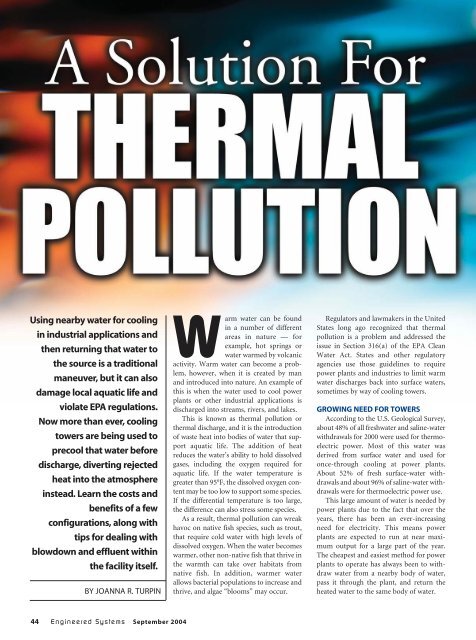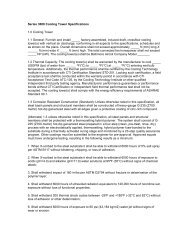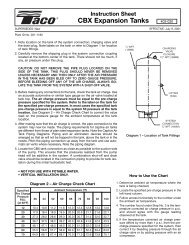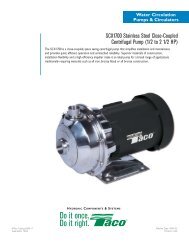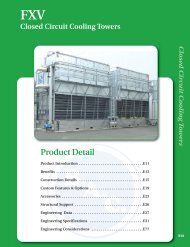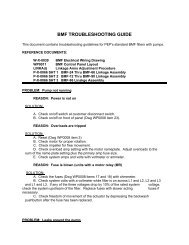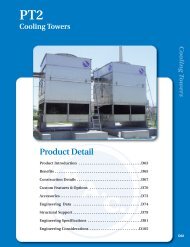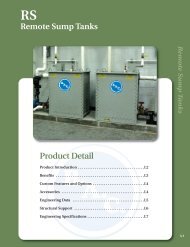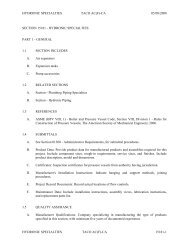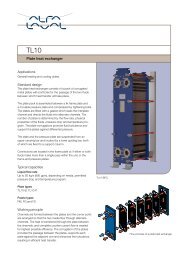SOLUTION FOR THERMAL POLLUTION.pdf - Emerson Swan
SOLUTION FOR THERMAL POLLUTION.pdf - Emerson Swan
SOLUTION FOR THERMAL POLLUTION.pdf - Emerson Swan
- No tags were found...
You also want an ePaper? Increase the reach of your titles
YUMPU automatically turns print PDFs into web optimized ePapers that Google loves.
Using nearby water for coolingin industrial applications andthen returning that water tothe source is a traditionalmaneuver, but it can alsodamage local aquatic life andviolate EPA regulations.Now more than ever, coolingtowers are being used toprecool that water beforedischarge, diverting rejectedheat into the atmosphereinstead. Learn the costs andbenefits of a fewconfigurations, along withtips for dealing withblowdown and effluent withinthe facility itself.BY JOANNA R. TURPINWarm water can be foundin a number of differentareas in nature — forexample, hot springs orwater warmed by volcanicactivity. Warm water can become a problem,however, when it is created by manand introduced into nature. An example ofthis is when the water used to cool powerplants or other industrial applications isdischarged into streams, rivers, and lakes.This is known as thermal pollution orthermal discharge, and it is the introductionof waste heat into bodies of water that supportaquatic life. The addition of heatreduces the water’s ability to hold dissolvedgases, including the oxygen required foraquatic life. If the water temperature isgreater than 95°F, the dissolved oxygen contentmay be too low to support some species.If the differential temperature is too large,the difference can also stress some species.As a result, thermal pollution can wreakhavoc on native fish species, such as trout,that require cold water with high levels ofdissolved oxygen. When the water becomeswarmer, other non-native fish that thrive inthe warmth can take over habitats fromnative fish. In addition, warmer waterallows bacterial populations to increase andthrive, and algae “blooms” may occur.Regulators and lawmakers in the UnitedStates long ago recognized that thermalpollution is a problem and addressed theissue in Section 316(a) of the EPA CleanWater Act. States and other regulatoryagencies use those guidelines to requirepower plants and industries to limit warmwater discharges back into surface waters,sometimes by way of cooling towers.GROWING NEED <strong>FOR</strong> TOWERSAccording to the U.S. Geological Survey,about 48% of all freshwater and saline-waterwithdrawals for 2000 were used for thermoelectricpower. Most of this water wasderived from surface water and used foronce-through cooling at power plants.About 52% of fresh surface-water withdrawalsand about 96% of saline-water withdrawalswere for thermoelectric power use.This large amount of water is needed bypower plants due to the fact that over theyears, there has been an ever-increasingneed for electricity. This means powerplants are expected to run at near maximumoutput for a large part of the year.The cheapest and easiest method for powerplants to operate has always been to withdrawwater from a nearby body of water,pass it through the plant, and return theheated water to the same body of water.44 Engineered Systems September 2004
Thermal PollutionFIGURE 1. This photo shows a substantial thermal pollution projectat the utility Cinergy Corporation. The company initially planned torent a cooling tower but instead decided to purchase 60 cooling towermodules on the theory that the units could later be relocated to otherlocations to solve other temporary heat rejection and thermal pollutionproblems. The pumps float on barges in the middle of the river,and a large conventional cooling tower can be seen at the lower left(Photo courtesy of Tower Tech).FIGURE 2. Commonwealth Edison used temporary cooling towers toreduce the temperature of its cooling canal before it flows into a nearbyriver (Photo courtesy of Tower Tech).These once-through cooling systems now require very strictenvironmental permits, issued in accordance with the National PollutionDischarge Elimination System. The permits vary from stateto state and location to location and may have different requirements.For example, some permits require that the plant must dischargethe water within a temperature differential limit over thetemperature of the intake water. Other permits have an ultimatelimit; in other words, they can’t ever exceed a specific temperature.Still other permits have both differential and ultimate limits.Depending on the permit, restrictions are often magnified duringlow river or lake levels, or drought conditions. That’s becausemost utilities see their peak loads in the summer months, when airconditioning loads are high. In addition, water temperatures are attheir highest in the summer, which can make it difficult for powerplants to comply with permit requirements.Cooling towers provide one way in which power plants can followpermit restrictions. “Cooling towers are the surest way to solvethermal pollution problems, because the cooling results can be predictedwith a high degree of accuracy prior to installing the towers,”said Robert C. Brink, president and CEO of Tower Tech, Inc. inOklahoma City.Since the need for cooling towers can be seasonal, some powerplants rent cooling towers as needed. In months where plants arebumping their thermal limits, they can install rental cooling towersto cool the effluent, provided there is reasonable access. “Thesefacilities pump all or part effluent through the cooling tower andthen back to the discharge to diminish the ultimate temperaturebefore it reaches the surface water,” said Kent Zammit, manager forcooling water technologies at Electric Power Research Institute(EPRI) in Palo Alto, CA.These installations are easier in the presence of a discharge canalthat provides access to the heated effluent and diffusion of thecooled water back into the effluent.ONCE-THROUGH OPTIONSCooling towers use evaporation to cool water, and their ability tocool is driven largely by the difference between the wetbulb temperatureand the desired cold water temperature. “Of course,”Brink said, “a cooling tower uses other variables to provide a certainamount of cooling, such as fill media, fans, motors, tower size, butit is this temperature differential that enables a cooling tower tocool water by evaporation.”Cooling towers are used frequently because they allow the userto reject heat from a system or process without consuming excessivequantities of water or thermally polluting a body of surface water.There are minor drawbacks, which are usually accepted as the priceof the larger benefit, according to David Hutton, P.E., process andpower market manager (international) for Baltimore Aircoil Company.These drawbacks are:• Higher operating temperatures than would be obtained fromsurface water or municipal water; resulting in some loss of thermodynamicefficiency;• Cost of electricity to run fans;• Drift, the discharge of minute water droplets which containminerals and other impurities;• Cost of water treatment to prevent corrosion, scale, and biologicalfouling of equipment; and• Risk of dispersion of airborne pathogens from poorly maintainedcooling towers.“Cooling towers solve the problem by shifting the rejection ofheat from bodies of water to the atmosphere, which has a muchgreater ability to absorb and dissipate the heat input withoutadverse effects,” added Hutton.Due to energy and environmental concerns, new power plantsare often being built with permanent cooling towers. A power plantthat incorporates cooling towers from the beginning of the designprocess can be better optimized with the other systems and components.Zammit states this might include using a two-pass condenser46 Engineered Systems September 2004
Thermal PollutionFIGURE 3. Modular closed-circuit cooling tower installed at a chemical refinery, rejects heat from process heat exchangers while eliminating thermalpollution of a nearby river. The tower protects the environment from accidental chemical discharges by isolating the process cooling watercircuit (Photo courtesy of Baltimore Aircoil).instead of a one-pass condenser, lower cooling water flow rates andhigher temperature differentials, and installing a turbine that isdesigned for higher backpressure. The cooling tower would also bedesigned to cool the entire flow.It would be difficult to install that type of equipment on a retrofitbasis, though. “Plants that are forced to retrofit typically compromisethe design,” said Zammit. “They’ll come up with somethingthat’s not quite as expensive to install, but they live with apretty severe energy penalty for the rest of the life of that plant.That, of course, increases their costs and decreases their ability tobid power to a deregulated energy market.”For these situations, temporary cooling towers may still make themost sense.CLOSED LOOP AND HYBRID OPTIONSSome power plants around the country have no choice but to goto closed-loop (recirculating) cooling systems. Depending on thearea, it may be due to a local moratorium on withdrawing waterfrom a river or lake. This happened recently to a major chemicalrefinery on the Gulf Coast, which elected to discontinue using riverwater for all of its plant cooling applications.“They ended up installing Baltimore Aircoil closed-circuit coolingtowers, eliminating approximately 500 million Btuh (146 MW)of thermal input into the river,” said Hutton. “Using closed-circuitcooling towers also eliminated frequent outages due to fouling oftheir heat exchangers.”There are drawbacks associated with closed-loop systems as well.Recirculating wet-cooling towers have an energy penalty associatedwith the additional pumps, fans, and auxiliary equipment and canalso require more extensive water treatment.According to a recent report from the National Energy TechnologyLaboratory, power plants with recirculating cooling systemsrequire from .5 to 1.25 gallons per kW to operate, while a plantusing once-through cooling withdraws about 30 to 40 times morewater on a gallon per kW basis.Although once-through systems withdraw significantly greateramounts of water (a 500-MW unit can withdraw approximately 450 milliongallons per day), consumptive losses are significantly less, about 10%of the consumption of a similar unit equipped with a wet-cooling tower.Due to these energy consumption concerns, some power plantsare opting for hybrid systems, which incorporate a recirculatingcooling system in combination with a once-through cooling system.The Brayton Point Station (1600 MW) in Somerset, MA, for example,will address thermal discharge and fish protection issuesthrough the installation of an enhanced multi-mode (EMM) system.“By utilizing the unique configuration of the cooling system, theyare able to use a single 20-cell tower to cool Units 3 and 4 in a recirculatedmode, or Units 1 and 2 in a helper mode,” said Zammit.OTHER SOURCES OF WATERIn many parts of the country, competing demands for freshwater have forced power plants to consider alternative coolingwater supplies. These “degraded” water sources can include treatedsewage effluent, contaminated or high TDS groundwater produced48 Engineered Systems September 2004
Thermal Pollutionfrom energy production, or reclaimed water. When used in conjunctionwith a cooling tower, there are different issues that have tobe addressed, such as loss of heat transfer, fouling of fill media, andcorrosion. There are also potential issues concerning the exposureof cooling tower operators to harmful agents.“There are definite questions about the issues you get with effluent,”said Zammit. “You may have to treat that effluent to be ableto manage it within the plant. If you have a high nitrogen or phosphorousloading, you have to be able to treat it to minimize any biofoulingin a system, because that can contribute to fouling, corrosion,and a lot of other problems.”The follow-up issue, Zammit points out, is what happens to theblowdown? “You eventually have to blowdown part of that water tokeep your system clean enough to operate without scaling it or foulingit to the point where it impacts operations.”In many cases, the treatment facility will accept the blowdown back,adding it to the front end of the treatment works or adding it to theexcess effluent being discharged. In some cases, it is necessary to treat theblowdown to remove any of the disagreeable components. It may evenbe necessary to use brine concentrators to reduce it down to dry salt fordisposal, depending on permit requirements.These issues all have to be evaluated when alternative water sourcesare used. Zammit said that EPRI just finished a project that investigatedthe formation of Trihalomethane (THM) compounds, whichcan form when organically contaminated waters (e.g., wastewatereffluent) are treated with chlorine or bromine for biofouling control.“It’s well known that if you brominate or chlorinate these organicallycontaminated waters you can form THM, a family of compounds thatare known carcinogens in sufficient concentrations.”There was a possibility of exposure that workers in and around thecooling tower in question may be exposed to the carcinogens. Fortunately,the testing showed that the formation rate of the carcinogeniccompounds is very low and the dissipation is very high. “We don’tbelieve, from the test results that we have so far, that it’s going to bean exposure issue, even for the operators who are in close proximity,”said Zammit.That’s good news, because from energy penalties to treatmentissues associated with degraded water, there are definitely somechallenges to using cooling towers in a power plant. But mostexperts agree that cooling towers are often the quickest, most effectivesolution to thermal discharge issues. ESTurpin is ES’ contributing editor.50 Engineered Systems September 2004


